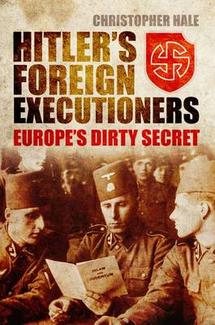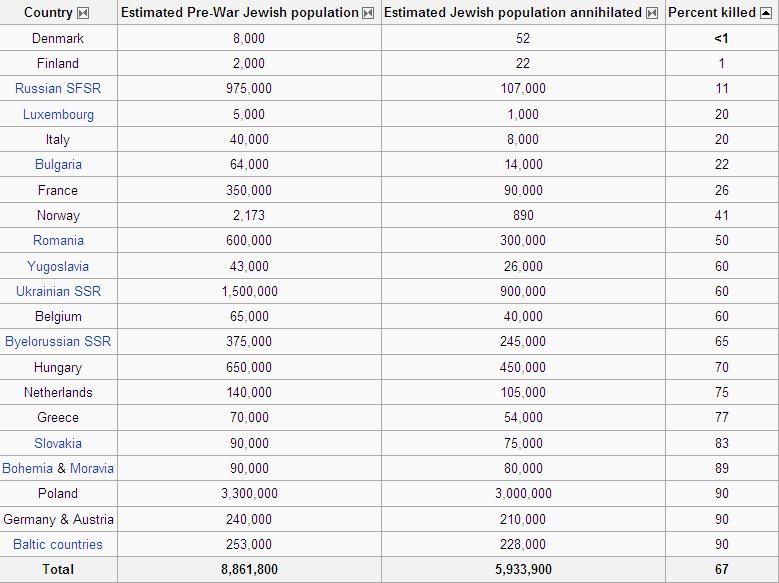Saving and Murdering in the Holocaust May 10, 2011
Author: Beach Combing | in : Contemporary , trackbackBeachcombing noted in this place a month ago – death-dealer of Kovno – that an important new book on Germany’s wartime atrocities is coming out: Hitler’s Foreign Executioners: Europe’s Dirty Secret by Chris Hale. CH argues in this work that subject populations of the occupied territories often partook enthusiastically in the Final Solution or ‘Outdoor Shooting’ (an inadequate term for the cold-blooded murder of more than a million Jews and countless Slavs) that preceded it.
Beachcombing can’t offer a conventional review here because he has known Chris for many years. But Beachcombing did have the very great pleasure of reading a pdf file of the manuscript just before it was sent to the presses and happily predicts that this will be one of the most important books to be published on World War II in the last and, indeed, the next decade.
Certainly, there is a kind of league table for occupied Europe where local enthusiasm for pogroms can be, to some extent gauged, by the percentage of the pre-war Jewish population that survived. So at the top comes civilised Denmark – only fifty two Danish Jews were killed by the Nazis, most of the rest escaping to Sweden – and, paradoxically, Italy with its racial laws. While at the bottom are the Baltic States and Poland where the woods were (to paraphrase a poem Chris quotes) ‘full of shrieks’ as hundreds of thousands were herded towards killing trenches and later into transports.
Of course, this league table cannot explain everything. For example, Poland was taken over in September of 1939 and was occupied until the Soviet Union ‘liberated’ the country in 1945. Even if every Pole had been a proven philo-Semite the Germans would have had time to round up most Polish Jews. Yet looking at the numbers above – with some head-shaking about the bizarre inclusion of Finland – it seems to do justice to the different levels of anti-Semitism in different European countries.
The only surviving film clip of a German massacre in the Ukraine, for example, shows the local villagers watching with curiosity as their Jewish neighbours are rushed in front of an einsatzgruppen firing squad.
CH’s book is a long overdue and comprehensive look then in English at those who helped Hitler with his racial campaigns and a fascinating glimpse into a thought world that has happily been exorcised by the almost universal revulsion we reserve for the German armed forces and their allies in WW2.
Take these two extracts from letters of members of the Danish (!) SS that bring us back to that all but forgotten logic.
A Jew in a greasy Kafkan walks up to beg some bread, a couple of comrades get a hold of him and drag him behind a building and a moment later he comes to an end. There isn’t any room for Jews in the new Europe, they’ve brought too much misery to the European people.
The other day we visited a large lunatic asylum near Munich and attended a lecture on racial science. It was fantastic to watch the mob of human wrecks they’d gathered there, I just wonder why they keep them alive… Afterwards we visited the famous concentration camp Dachau and saw it from one end to the other. It was a great experience; you all know what one hears about concentration camps in Denmark, like the rest, it’s lies from end to end.
In bringing such accounts into the light of day Chris’s book is the natural compliment to Samuel Oliner and Pearl Oliner’s The Altruistic Personality: Rescuers of Jews in Nazi Europe (1988) that concentrates, instead, on those who risked their lives to save neighbours and strangers from the swastika.
The following extract relates to a Jewish group in Italian-occupied Yugoslavia and might stands against the Jew-hating Danish SS volunteers quoted above.
The Germans insisted that we [Jews] all be handed over to them. So we were arrested by the Italian military to save us from being handed over to the Ustases [the Croatian security police] and to the Germans. It was a measure of compassion to save us because the Italians had seen terrible things that the Ustases did in the concentration camp in Belgrade… One day the commanding officer came to me and said ‘I think the situation is very precarious. The Germans may come any day. But I have’ – and this was one of his most generous gestures – ‘an ambulance car here in the garage with enough gasoline to travel thirty kilometres to Italy, across the border. I have given the name of five persons to the driver because I am going on vacation and don’t want you to remain unprotected. So even if the Germans should come, you will be put in an ambulance car and taken to the kingdom [i.e. Italy].’ I cannot imagine anyone but an Italian making such a gesture. He said ‘I was always a fascist. I will not deny being a fascist, but I will never accept anti-Semitism and the persecution of the Jews.’
Reading the Oliners’ classic and Foreign Executioners side by side will give you a sample – there are pages on the massacres in Romania and Yugoslavia that Beachcombing will never forget – of the best and the worst that humanity has to offer.
And which side has the most scores on the ledger? The murderers or the rescuers?
Well, CH’s book is about 450 pages in length, fifty pages longer than The Altruistic Personality. The shallowest possible criteria, but for Beachcombing it says it all.
‘And far away in some recess
The Lord and the Devil are now playing chess
The Devil still cheats and wins more souls
And as for the Lord he is just doing his best…’
***
18 May 2011: Virginia writes in with this comment: ‘Your post on the new book on the Holocaust reminded me of Christopher Browning’s Ordinary Men. I read it years ago as part of an undergraduate anthropology class – selected by the lecturer in order to raise the question of accountability. I recall heated arguments in class over whether or not men like the subject of the book had an option – did kill or be killed / arrested / sent to a camp excuse the actions of these men, or could they be held morally responsible for the killings they performed? A more pointed question might be, was anti-Semitism generally so prevalent that the Nazi directives were welcomed to some extent? This is hardly my historical period of expertise, but where stories of retaliation against Nazi collaborators are easily found in France for example, I can not recall ever hearing such a thing for Poland, the Baltic countries, et al. where far greater numbers of the Jewish population were eliminated by either Nazis or their local enforcers. In retrospect, perhaps the ability for humanity as a whole to cope with the magnitude of what occurred during those years across Europe necessitated a single, definable group / madman to blame, so it became easier to identify these atrocities with the Nazis and Hitler, and the willingness of others, or at the very least their complacency, was simply beyond comprehension, thus allowing for their disappearance from historical consideration.’ On this subject one of Beachcombing’s students, Emma, put Beach onto a disturbing Holocaust book named the Kindly Ones by Littell that sounds like it would be worth reading. Thanks Virginia!!
22 May 2011: Umbriel writes in with some reflections on the inclusion of Finnish victims of the Holocaust. ‘My wife happens to be a professional statistical analyst in an academic setting, and through her my sensitivity to issues of this sort – definitional gray areas in data – has become heightened. Wikipedia echos your figure for deaths of Finnish Jews citing Israel’s Yad Vashem museum as its source, and noting that all of them were casualties in Finnish Army service. Yad Vashem’s figures would appear to simply reflect ‘deaths in the Shoah’, and are probably simply the difference between pre- and post-war population totals. Some fraction of all of those death totals are likely not deaths directly attributable to Nazi extermination efforts, but rather from a variety of other causes, including civilian collateral damage from combat, deaths of Jewish combatants in Allied service, Allied bombing casualties, murders committed by the Soviets during the ‘Sovietization’ of the Baltics and Eastern Poland, etc. In most cases those definitional uncertainties amount to no more than statistical ‘noise’ against the overall Nazi atrocity record, but when the numbers get as low as in Finland’s case, they become a bit more significant. Arguably Finland’s hands aren’t 100% clean with regard to the Holocaust – as the Wikipedia listing points out, Finland did turn over some Soviet POWs and a handful of foreign refugees to the Nazis, though more of those subsequently killed were Soviet commissars than were Jews. Whoever put up these numbers presumably didn’t spend much time parsing the data he got from Yad Vashem, as it was tangential to his main point, but I would agree that including Finland in the tally was odd.’ Thanks a million Umbriel!
19 Sep 2015: Louis writes, ‘As I was browsing your site, I came across the above post. As I read the high portion of deported jews from The Netherlands, I was reminded of one of the reasons usually given in The Netherlands for that. Our bureaucracy\civil service\municipal registration system was so good, that the occupiers only had to consult that, to round up all jews (as religion was marked on the index card, as that was important for internal\national politics). Those same records were also used in the rationing, which made it more difficult to obtain food for jews (and other people, like allied aircrews, draft dodgers, and forced labour dodgers) in hiding. Therefor these administrations became the target of attacks by the underground. And then there was the institution of the Jewish Council (Joodse Raad). I think that this was an institution uniquely dutch, as I have not come across anything like this in other occupied countries. Basically it was a council of prominent jews that was to administer the deportation of all picked up jews, for the german occupiers. As the people on the council were the most prominent, and also the most assimilated, they made it their policy to preserve the best and brightest as long as possible, to ensure a continued high level jewish presence after the war. This meant that all the more ‘unsavoury’ (and more visible jewish) people were transported first. These were mostly recent immigrants from eastern europe, not the old portuguese jewish families who arrived in the 1600’s (Spinoza being one of them…). After the war this was reason for much resentment within the jewish community…
29 Sep 2016: M writes ‘I just noticed your post regarding the numbers of Jews killed in different countries during the Shoah, and an email comment from a reader you have added to the post about the 22 Jews killed in Finland probably having died in military service. Finnish Jews fought in the Finnish Army alongside the Germans between 1941 and 1944; three of them (two infantry officers and one female nurse) won Iron Crosses 1st Class because they impressed the Germans so much. See here, for example.




